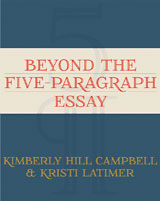Respect for Young Writers
Beyond the Five-Paragraph Essay
by Kimberly Hill Campbell and Kristi Latimer
(Stenhouse Publishers, 2012 – Learn more)
Beyond the Five Paragraph Essay by Kimberly Hill Campbell and Kristi Latimer is a book for all teachers who feel, as the authors do, that the five-paragraph essay format encourages students “to say very little in a very organized way.” It is a book written with respect for young writers, who deserve the chance to take on the tough, thought-intensive and deeply satisfying work of authentic literature responses. Teachers discouraged by the lack of original thought and creativity in student writing will value Campbell and Latimer’s insightful book for providing a process, plan and alternative writing formats that breathe life back into student writing.

So it was with particular enjoyment that I read the first chapter of Campbell and Latimer’s book. The authors bravely advance upon our education system’s fierce attachment to the five-paragraph essay, and proceed to eviscerate this sacred cow of secondary education. The authors argue that the five-paragraph essay format:
- is not a structure used beyond the school walls;
- stifles intellectual exploration;
- is not useful as a writing “starting point,” as most students never move beyond the formula;
- limits the development of struggling writers; and
- leads to frustrated college professors who wonder at the shallow, uninspired writing produced by incoming students.
Not only do the authors back all these assertions up with research, they also provide evidence that the five-paragraph structure does not prepare students to score well on standardized tests. One major study found that only students who moved beyond the five-paragraph structure received above average marks on state writing tests. I found this reassuring evidence that the poor souls who have to read all of those standardized tests have not been totally dulled into apathy!
Better strategies

The authors also provide pragmatic strategies of how to teach students to look for craft, structure and theme. Through this work students use their writing to explore their thinking and to ask questions of the text, questions that lead to eventual essay topics. Helpful strategy summaries in matrix form are scattered throughout the text, providing detailed summaries of approaches for teaching students to respond to their reading in a way that inspires their writing.
The authors feel strongly that it is important for students to write “low stakes” literature responses to both discover thinking and communicate thought. Their strategy summaries for using journals, slideshows, haiku, collages and bookmarks serve as brief lesson plans that teachers can put directly to good use. As I read this section of the book my pen and stickies were flying, marking activities to use this fall.
After laying the groundwork for teaching students how to use their writing to “support their thinking about a text,” the authors discuss exploratory essays, “where one does not so much advance an argument, as examine and explore avenues for solving an interpretive or critical problem.” Then in the final chapters of the book the authors give guidance on how to “support students in learning to write with purpose and authority in an organized, analytical essay free of formula.”
One concern about the final chapters
There is much to like in the last section of the book. Campbell and Latimer provide explicit guidance on drafting inspired theses statements, ideas on thoughtful inclusion of text evidence and useful resources to use as essay examples. However, I felt that readers were left hanging in these last chapters.
Developing a curriculum that allows “a student’s thought process to determine the form (of an essay), and not the other way around” is challenging. The final chapters lack the explicit guidance that is so nicely provided in the earlier chapters. Really, the book might need to be twice as long to truly provide a full program of non-formulaic approaches to the beautiful art of essay writing.
That said, I still strongly recommend Beyond the Five Paragraph Essay. It may not have everything needed to eradicate the hollow and rigid writing structures inflicted upon our young, but it certainly provides an excellent start.
Liz Wisniewski teaches fourth graders in Massachusetts. She is an avid bibliophile, whose penchant for collecting books has resulted in a classroom library that is the envy of all local teachers. Prior to teaching Liz worked as an economist in the energy industry, negotiating electricity rates for generating plants.































